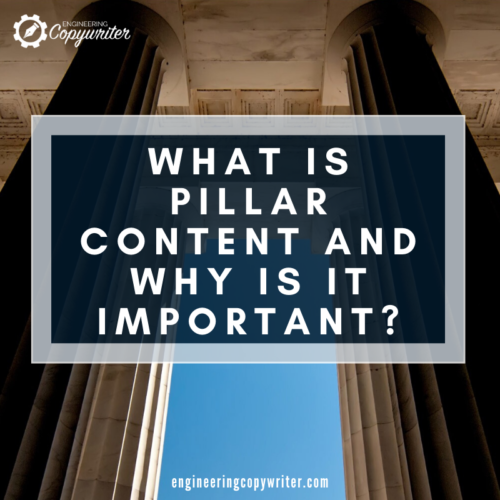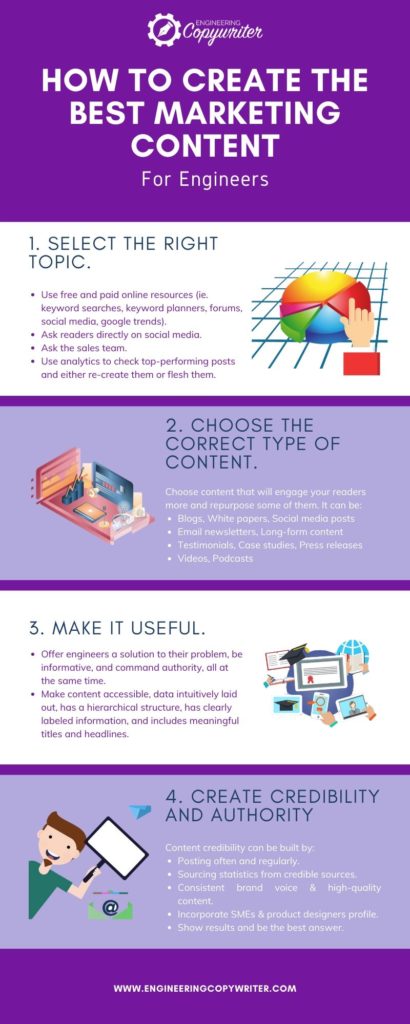2. Examine core topics
When planning your pillar content, start with broad topics that you can break down into smaller sections. Take a look at your brand, your products, and the services that you offer, then answer the following:
-
- What is your main product?
- What are the manufacturing capabilities that you excel in?
- What solutions do you offer?
- What does your brand want to be known for?
Write down your answers. Ideally, these can become the keywords that you’ll aim to rank for. The broader the topic, the better. It can be difficult to aim for a 1500-3000+ word article when your topic is too specific. Give yourself space to discuss topic subsets and related ideas.
3. Add engaging visuals like videos and infographics
Pillar content write-ups are quite long and can be overwhelming to read if the text is not broken up. To help your readers digest a lot of information, it is important to include engaging visuals throughout. Visuals such as videos and infographics provide a breather for the reader. The good news is that you don’t have to spend hours creating these visuals – take a look at the examples below:
-
-
- – Embedded tutorial videos that demonstrate a process you have discussed in the text.
- – An illustration of a machine.
- – A blown-up graphic of a relevant quote that you want to highlight.
- – A graphical presentation of data that supports a claim you have mentioned in the post.
- – An infographic that summarizes important points in a particular section.
4. Update your pillar content regularly
Pillar content aims to educate and give updated and relevant information. Engineers, in particular, want updated information so they can make timely and accurate manufacturing decisions. When your pillar content provides outdated data, engineers are less likely to trust your firm as a helpful source. Update your content at least once a year. This will improve the traffic performance of your content and increase your brand’s authority on engineering topics.
5. Promote your pillar content
No matter how comprehensive your pillar content is, the effort will be wasted if your readers don’t know about it. Engineers won’t necessarily find content on their own, so you must devote time and effort to promoting your pillar content to increase both website traffic and article awareness. Promote your pillar content by:
-
- – Including a snippet of an intriguing discussion in your email newsletter with a link to the full article on the website.
- – Sharing your infographics or other visuals on your social media profiles.
- – Including the content in press releases.
- – Referring people to new engineering blog posts by adding internal links leading to the pillar content.
- – Using marketing ads to raise awareness.
- – Make sure the articles are visible on your website’s landing page through a call to action.
Importance of having pillar content

1. Build your engineering authority
High-quality pillar content can help you build your engineering firm’s online visibility and reputation. When you provide valuable information, visitors will recognize you and see you as an authority in your industry. If your engineering website frequently publishes high-quality pillar content, engineers will return more often and your website will be their go-to reference whenever they have questions or want to learn more.
2. Improve your SEO
Pillar posts frequently rank highly in search engines because their algorithms prefer extensive, in-depth content that provides value. When you post high-quality articles, other engineering websites can link to you through backlinks. Backlinks increase your website’s authority and help you rank higher in search engines.
Viewing time is an important metric too. Pillar content and other long-format articles take longer to read, driving up your stats. They also afford you plenty of space for relevant keywords, further enhancing your ranking. Just remember, your writing needs to be enticing enough to keep readers engaged throughout its whole length.
3. Pillar content is evergreen
Because it discusses broad subjects, pillar content will remain relevant longer than most blog topics. Pillar articles can cover topics in broad strokes, the fundamentals of which don’t often change with new technology. Your shorter, more specialized articles are likely to become outdated quicker than the more evergreen pillar articles like:
-
- – How-to guides
- – Machine tutorials
- – Processes or machine histories
- – Industry resources
- – Material pages
Ideally, this type of content won’t change much with time or current events. While pillar content garners a consistent level of interest and traffic, it is still important to review it from time to time. Monitor the traffic and check its information just in case readers need to know about any updates.
4. Increase leads, conversions, and sales
Your chances of getting more leads and conversions will increase as your website traffic increases. This is exactly where pillar content excels. As mentioned above, SEO likes long-form content, so it can help place your site on the first page. Being on the first page puts your content in front of a lot of viewers. Additionally, pillar articles are great marketing tools that exhibit your expertise on a certain topic. Engineers are very critical of how information is presented to them. They can easily tell if you are an expert or not. When you gain their trust through your content, they are more likely to buy your products or your services.
5. Encourage email subscribers
Most marketers set a goal of creating and expanding an email list. Such a list allows you to communicate with your readers directly. Pillar content is an excellent way to get readers to sign up for these direct updates. When you consistently publish relevant and high-quality pillar content, you’ll have an easier time convincing the engineers who read it to seek more from you. You can also provide valuable lead magnets or content upgrades throughout the post via calls to action to get them to leave their email address.





 An effective piece of pillar content should comprehensively discuss a major engineering topic with the aim of providing value and ranking highly in search engines. Below are some tips to create one.
An effective piece of pillar content should comprehensively discuss a major engineering topic with the aim of providing value and ranking highly in search engines. Below are some tips to create one.

